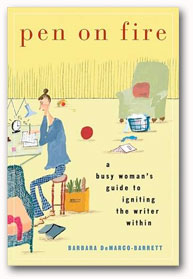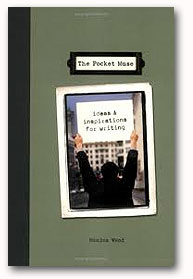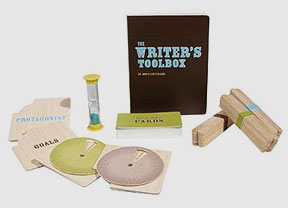hy does it so often seem that for some of us, the hardest part of “creative writing” is the “creative” part? How can simply coming up with an idea, getting those first few words out, and spinning something new seem so overwhelming? Seven years after earning my M.F.A., I can still find myself stuck and stymied. Frequently, prompts and exercises have come to my rescue.
How might prompts and exercises similarly help you? Here are just a few possibilities:
- Getting you started: Many years ago, I realized that we’d never tell someone to run a marathon without undergoing training and warm-ups beforehand. Similarly, to expect anyone to embark on a full-fledged career as a writer without at least trying some exercises first seems, at best, ill advised.
- Getting you “unstuck”: I know—“writer’s block” is a touchy phrase. Some people refuse to believe the phenomenon exists. But for some of us, it can be a harsh reality. If you need a little something to get those creative juices flowing again, a prompt or exercise may be just the thing.
- Getting you published: It happens. Something you began writing because it was assigned as an exercise becomes something publishable. In fact, it has happened to me. “Rio, 1946” began as an overnight point-of-view exercise during a week-long summer workshop. More recently, several poems written in response to instructors’ assigned prompts have found their way to readerships beyond my instructors, my classmates, and me!
- Fitting into your schedule: Sometimes, we may say that we simply don’t have time for our writing. Sometimes, we may be right. But here’s a beautiful thing about prompts and exercises: They’re not novels! You can squeeze them into a few minutes—and give yourself credit for work completed.
- Honing specific techniques: If you’re struggling to enliven characters, spice up some dialogue, or experiment with a new narrative point of view, there are plenty of exercises focusing on just those skills that are available to help you.
Other writers and instructors share their thoughts about the use of prompts and exercises:
- Jessica Handler, author of the memoir Invisible Sisters: “I use prompts in writing classes on the undergrad level and in workshops to create a level of comfort with the act of writing and to pretty much force people to do the work. Prompts are tailored to class topic, e.g. freewrites about a key question in the work in progress, or a dialogue exercise for which I provide the first line. I rely heavily on freewrites in my own work, and keep entire notebooks of completed freewrites.”
- Ellen Meeropol, author of the forthcoming novel House Arrest: “In the workshops I lead, I rarely use prompts, but I frequently use exercises as a way to encourage writers to try new techniques—such as a point of view switch, a merge of dialogue and gesture, changing the gender or race of a character.”
- Stephanie Vanderslice, Associate Professor of Creative Writing at the University of Central Arkansas and Director of the Great Bear Writing Project: “I get a lot out of writing along with my students to whatever exercises I’ve given them—then continuing with it during my own writing time. So, in that way, exercises do work for me. I start out just wanting to model for my students and end up with something to work on.”
Fortunately, it’s not essential to sign up for a writing class or workshop in order to benefit from the creative inspiration of prompts or exercises. There are plenty of resources you can pick up in print, or online, whether you're focusing on poetry or prose. Below, you’ll discover some that you may find especially helpful.
Remember, you need not pursue all of the prompts and exercises that these resources contain. As writer and professor Rachel Hall says, “Like breathing patterns for labor, you really only need one or two, and they have to feel natural, not imposed.”
In Print

Now Write! Fiction Writing Exercises From Today's Best Writers and Teachers edited by Sherry Ellis (Tarcher, 2006)
If you look at the pages I’ve tagged with post-it notes in my copy of Ellis’s book, here’s some of what you’ll find: Eileen Pollack’s “Look Backward, Angel,” an exercise on writing in “first-person retrospective, in which a first-person narrator looks back on an event that occurred a long time ago, or at least far enough in the past to allow the narrator to gain new perspective”; “Let the Dead Speak,” an exercise from Laura Kasischke that invites the writer, as you may have inferred, to “conjure a ghost”; Sands Hall’s “Dialogue Without Words”; and “Finding a Larger Truth by Turning Autobiography Into Fiction,” by Susan Vreeland. And I’ve only given you a few examples of my tagged pages here.
NB: If you're a nonfiction writer, you may want to check out Ellis’s follow-up volume, Now Write! Nonfiction: Memoir, Journalism and Creative Nonfiction Exercises from Today's Best Writers (Tarcher, 2009).

Pen On Fire: A Busy Woman's Guide to Igniting the Writer Within by Barbara DeMarco-Barrett (Harcourt, 2004)
A key premise underlying this book is this: Every bit of time counts, no matter how small it may seem. In the world according to DeMarco-Barrett, you will no longer sit there doing nothing for those 15 minutes you spend waiting for the doctor or dentist to see you. You will write. (You will no longer waste those precious moments “while the water’s boiling, the coffee’s dripping, during TV commercials” either.) DeMarco-Barrett bases many of the book’s other lessons and exercises on this fairly simple premise: Everyone—even the busiest multi-tasker of the twenty-first century—can find 15 minutes to write.
The brief chapters, focused on specific topics with tailored exercises provided at each one’s conclusion, enhance this sense of feasibility. When DeMarco-Barrett addresses the topic of “creating tension” in one’s writing, for instance, she assigns an eminently do-able 15-minute exercise: “Do you have a list in your notebook headed ‘Crises’? If not, make that list now.” This book is extremely well-written, well-organized, and practical.

The Pocket Muse: Ideas & Inspirations for Writing by Monica Wood (Writer’s Digest Books, 2004)
I love this book, which came to me as a gift from another writer. Its small size and sturdy cover make it easy to slip into a handbag. Its smooth pages, lovely photographs, and artful design are a delight to touch and behold. Most important, it’s utterly non-intimidating. Some pages include very few words: “Write about a roll of film that has been obtained surreptitiously.” “A character arrives at work to find her chair missing. What happened to it?” “Write about a simple board game that turns its players into pie-eyed cutthroats.” Other pages feature lengthier commentary on style or revision. Writerly quotations pop up from time to time. Overall, this book truly lives up to its title.
(One day, I should probably pick up a copy of the sequel, Wood’s The Pocket Muse Endless Inspiration: New Ideas for Writing [Writer’s Digest, 2006].)

Writing the Life Poetic: An Invitation to Read and Write Poetry by Sage Cohen (Writer’s Digest Books, 2009)
If you can’t take a poetry class with Sage Cohen (disclosure: I’ve taken two, so far), then getting yourself a copy of Writing the Life Poetic may be the next best thing. Whether you’re a beginner or a more experienced poet, you’ll find this book to be the “creative companion” that Cohen promises it will be in her introductory message. Throughout the book, Cohen’s encouraging “Try This!” sections provide specific exercises to complement mini-lessons on aspects of poetic craft and practice. As a still-novice poet, I’m especially grateful for the lessons—and accompanying exercises—on such elemental topics as lines and line breaks.
Another section I like a lot: “Writing Poems from Titles,” in which Cohen provides nearly three dozen actual poem titles and encourages the writer to try writing her own poems from them. “Think of this list as a book of matches,” Cohen writes. “Anytime you get stuck or are unsure what to write, you can start a creative fire with a title that sparks something in you.” Ever the teacher, Cohen also suggests that once you’ve finished writing a poem based on one of the supplied titles, “find the original version and enjoy how your poems compare. You may be surprised at what a range of possibility a single title invites—and can accommodate!”
Online
Lori Ann Bloomfield’s “First Line”
Novelist Bloomfield describes the First Line site as follows: “Here you will find writing exercises that will jumpstart your imagination and inspire you as a fiction writer. Every Wednesday, I post a first line that you can use as a starting point to write your own fabulous, tragic, magical, hilarious, and hopefully award-winning short story. Want more? Check back often for other exercises designed to keep the words flowing. You’ll also find the occasional quote or review of a book about the craft of writing. And some days there are musings from me as I share my own journey as a writer.”
Bernadette Mayer’s “Writing Experiments”
Poet Bernadette Mayer’s list of writing experiments has been around for quite some time, and is frequently cited when other poets and writers talk about useful prompts and exercises. You will find these experiments conveniently collected on the website of the University of Pennsylvania (Penn) Extension of the Electronic Poetry Center (PEPC).
Midge Raymond’s Newsletter and “Ask Midge” Column
I’ve admired Midge Raymond’s short stories for a long time, so when I saw that this author was offering a free newsletter, I was quick to subscribe. Each issue includes a writing exercise. (Raymond has begun posting the exercises on her blog, too.) Here’s a sample from earlier this year:
“Write a review of your current project (i.e., your novel, a poem, a story, etc.).
Take a step back from the work and try to see it objectively. Write the review as if the piece is already published, and be honest in terms of what works and what doesn’t (adopt the style of your favorite book reviewer if this helps you get some distance). Be specific—cite examples, quote from the work itself—and then put it away. Wait a week, then take out the review and look it over. Pay attention to what it tells you about your project: first, where you are, and second, where you’d like to be.”
Raymond also references exercises in the responses she’s penning for her new “Ask Midge” column. Check it out—and if you have a craft-related question, send it along! You may just receive an exercise (or several) in Raymond’s response!
Lisa Romeo’s “Prompt Projects”
All through July and August, I received a daily writing prompt via e-mail from Lisa Romeo, a prolific nonfiction writer. This Summer Prompt Project evolved from the success Romeo encountered with a similar endeavor last winter, when she offered to send a daily writing prompt—the same prompts she provides to her writing students and coaching clients—for sixty days to anyone who wanted them. Romeo’s prompts are brief (one line, sometimes one word), and utterly open-ended. As Romeo says, “My bottom line is always this: If you manage to do no other writing that day, then a few lines in response to the prompt may help you to continue to feel like a CREATIVE writer.” Want to be sure you find out when Romeo’s next Prompt Project gets under way? Email LisaRomeoWrites@gmail.com.
Meredith Sue Willis’s “Writing Exercises”
Author and teacher Meredith Sue Willis offers writing exercises online, noting that she calls them “exercises” instead of “prompts” because “I think of them as ways to strengthen the writing muscles that you already have and as ways to expand your range of techniques.” At last count, Willis had provided more than 180 exercises for you to choose from.

In addition to the books and e-offerings listed above, you can also find resources that aren’t adequately described by the adjectives “print” or “online.” I’m thinking, for example, of author and creative-writing teacher Jamie Cat Callan's creation, The Writer's Toolbox: Creative Games and Exercises for Inspiring the 'Write' Side of Your Brain. Packaged in an actual and attractively-designed container, The Writer's Toolbox contains exercises printed on what appear to be Popsicle sticks (divided among “First Sentences,” “Non Sequiturs,” and “Last Straws”); a set of “Sixth Sense” cards to propel creative and sensory-rich descriptions; and four “spinner palettes” to help your plots thicken.
If this all seems a bit disjointed and confusing, don’t worry. The accompanying 64-page booklet explains clearly and quickly exactly how to use each tool.
Callan, who has taught writing in diverse settings (elementary schools, senior-citizen centers, universities and prisons among them), espouses a “right-brain” approach to the process. “Whether you’re a seasoned writer or a beginner,” she promises early in the booklet, “you’ll enjoy the games in The Writer's Toolbox. They are all fun and not at all intimidating. Instead, they're visual sensory, and tactile.”
A final note: In this article for WOW!, I’ve focused on books and resources written and/or edited by women writers. But women don't have a monopoly on writing prompts and exercises! There are at least a few good men with similar resources to offer. At the top of my list:
These prompts and exercises should keep you busy for a while. Much more importantly, they should keep you inspired—and writing.
***

Erika Dreifus is the author of Quiet Americans, a short-story collection forthcoming in January 2011 from Last Light Studio Books. A contributing editor for The Writer magazine, Erika also publishes “The Practicing Writer,” a free monthly newsletter for fictionists, poets, and writers of creative nonfiction.
Please visit her at her new website, www.erikadreifus.com.